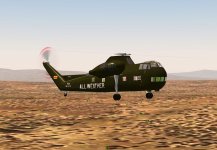Mick
SOH-CM-2025
Well, it took over a year and some difficult struggles with FS9, which does not like multi-engined piston-powered helicopters at all, but David and I have finally finished with our Sikorsky S-56. Here's from the introductory blurb about it:
The S-56 was a revolutionary helicopter. It was the first production twin engined helicopter and one of the first helicopters with retractable landing gear. It established World Speed, Altitude and Lifting records and had some very advanced features. Developed as a heavy assault transport for the Marine Corps as the HR2S, where it acquired the nickname "Deuce" (for the 2 that differentiated its designation from its predecessor, the HRS), the Army took interest and got its simplified H-37, formally named Mojave, into service first. The H-37A entered service in 1956 and the HR2S-1 in 1957. The last CH-37B was retired from the National Guard in 1974. An AEW version was developed for the Navy but it wasn't successful. In the early 1970s, Keystone helicopters modified surplus airframes for civilian use but had little success. Both regular and wide screen panels are included, along with multiple models and skins depicting the XHR2S-1, YHR2S-1, XHR2S-1W, HR2S-1 (CH-37C), H-37A, CH-37B and S-56 in the authentic colors and markings of the U.S. Marine Corps, Army, Navy, Federal Aviation Administration and Keystone Helicopters.
Here's a screenie of a YHR2S-1 being tested at the Naval Air Test Center, NAS Patuxent River. They named it Jonah but it looks more like the whale:

And here's an Army aircraft, "Tired Dude" of the 90th Transportation Company based in Germany:

This HR2S-1 shows HMH-461's ferocious squadron motif:

The S-56 was a revolutionary helicopter. It was the first production twin engined helicopter and one of the first helicopters with retractable landing gear. It established World Speed, Altitude and Lifting records and had some very advanced features. Developed as a heavy assault transport for the Marine Corps as the HR2S, where it acquired the nickname "Deuce" (for the 2 that differentiated its designation from its predecessor, the HRS), the Army took interest and got its simplified H-37, formally named Mojave, into service first. The H-37A entered service in 1956 and the HR2S-1 in 1957. The last CH-37B was retired from the National Guard in 1974. An AEW version was developed for the Navy but it wasn't successful. In the early 1970s, Keystone helicopters modified surplus airframes for civilian use but had little success. Both regular and wide screen panels are included, along with multiple models and skins depicting the XHR2S-1, YHR2S-1, XHR2S-1W, HR2S-1 (CH-37C), H-37A, CH-37B and S-56 in the authentic colors and markings of the U.S. Marine Corps, Army, Navy, Federal Aviation Administration and Keystone Helicopters.
Here's a screenie of a YHR2S-1 being tested at the Naval Air Test Center, NAS Patuxent River. They named it Jonah but it looks more like the whale:
And here's an Army aircraft, "Tired Dude" of the 90th Transportation Company based in Germany:
This HR2S-1 shows HMH-461's ferocious squadron motif:



